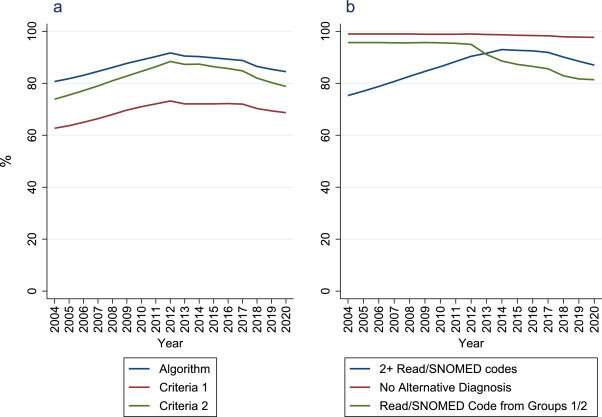Percentage of patients with at least 1 Read/SNOMED code for RA who meet the diagnosis algorithm. Panel A = percentage of patients ever receiving an RA Read/SNOMED code that meet the algorithm and each of its criteria in each calendar-year; panel B = percentage of patients ever receiving an RA Read/SNOMED code that meet each criteria 2 component in each calendar-year; 2+ Read/SNOMED codes = having ≥2 Read/SNOMED codes (on different dates); no alternative diagnosis = no Read/SNOMED code for an alternative form of IA after the final RA Read/SNOMED code; Read/SNOMED code from groups 1/2 = having a Read/SNOMED code from strength of evidence code groups 1 (“strong” evidence) or 2 (“fairly strong” evidence) as opposed to 3 (“fairly weak” evidence) or 4 (“weak” evidence). Credit: The Lancet Regional Health - Europe (2022). DOI: 10.1016/j.lanepe.2022.100519
The proportion of adults in England diagnosed with inflammatory arthritis has increased by at least 40% between 2004 to 2020, new Keele University research has found.
Inflammatory arthritis groups together conditions causing joint pain and swelling. Its three main types—rheumatoid arthritis, psoriatic arthritis, and axial spondyloarthritis—cause long-term pain and disability and have high costs to the UK economy. The earlier people with inflammatory arthritis receive specialist treatment, the better their outcomes.
Led by Dr. Ian Scott from Keele University's School of Medicine and Midlands Partnership NHS Foundation Trust, this study published in The Lancet Regional Health—Europe looked at the proportion of adults in England with a diagnosis of one of these three conditions in each year from 2004 to 2020.
Planning NHS services to deliver early and appropriate specialist treatment to patients with inflammatory arthritis requires understanding how many people in England have these conditions. To address this, the research team looked at data from a large GP database—the Clinical Practice Research Datalink Aurum—which currently includes information from over 1,400 GP practices across 20% of England. They looked at data from 2004 to 2020, to understand how the prevalence of inflammatory arthritis diagnoses have changed in that time.
They found that the proportion of adults in England with a diagnosis of one of these forms of inflammatory arthritis increased over the study period by at least 40%. This meant that in 2020 over 1% of adults and over 2.5% of those aged over 65 years in England had a diagnosis in their GP records of one of these conditions.
Lead author, Dr. Ian Scott says that their "findings have significant implications for the NHS in England. Many studies have shown that the earlier people with inflammatory arthritis receive specialist treatment the better they do, and it is very important that people with new onset inflammatory arthritis or suffering a flare of their arthritis are seen quickly. Organizing NHS services to enable this is vital."
"Our results show that these conditions are more common in people aged over 65 years. This highlights the need to consider older people when planning arthritis NHS services. We need to particularly make sure that the widespread move to online healthcare does not adversely affect older people with arthritis, as other studies have shown they are less likely to use the internet and have the essential digital skills to access it independently."
More information: Ian C. Scott et al, Rheumatoid arthritis, psoriatic arthritis, and axial spondyloarthritis epidemiology in England from 2004 to 2020: An observational study using primary care electronic health record data, The Lancet Regional Health—Europe (2022). DOI: 10.1016/j.lanepe.2022.100519
Provided by Keele University























